INSTITUT SUPERIEUR D'ANTHROPOLOGIE
INSTITUTE OF ANTHROPOLOGY
ONLINE COURSES / COURS A DISTANCE
DEBUT COURS : SEPTEMBRE 2023
REGISTER NOW
KAZAKHSTAN – 
 Ainabulak-Temirsu - Archaeologists in eastern Kazakhstan have unearthed a Bronze Age burial mound of a girl surrounded by various grave goods in the Ainabulak-Temirsu Necropolis. The young girl was laid to rest with a number of peculiar grave goods, including 180 animal ankle bones and a small, exquisite silver accessory depicting a frog on a disc. According to The Astana Times, an English-language news outlet in Kazakhstan, the girl’s grave is located near Ainabulak village in the east of the country and dates from Central Asia’s Bronze Age, which lasted from roughly 3200 B.C.E. until 1000 B.C.E. Rinat Zhumatayev, an archaeologist who led the excavation and heads the Department of Archaeology, Ethnology and Museology at Al-Farabi Kazakh National University in Kazakhstan, said: “She was buried on her left side, bent over. Small wire earrings were in both ears and beads around her neck.” The frog-adorned artifact carries immense significance. Scholars associate the frog motif with water-related rituals found in China and Egypt, adding an intriguing layer to the ongoing research. According to the researchers, this is the first example discovered in Kazakhstan and may be associated with the image of a woman in labour and the cult of water. The sheer volume of animal bone fragments buried in the burial mound also piqued researchers’ interest. The number of bones buried with this person was extravagant compared to other graves on the Eurasian steppe that contained animal remains, frequently in child and adolescent burials. Some scientists think that the burial of astragalus bones was part of a “cult practice” and that the bones were used during meditation. However, other researchers view the bones as “symbols of well-being” and “good luck” that served as a “wish for a successful transition from [one] world to others,” Zhumatayev said.
Ainabulak-Temirsu - Archaeologists in eastern Kazakhstan have unearthed a Bronze Age burial mound of a girl surrounded by various grave goods in the Ainabulak-Temirsu Necropolis. The young girl was laid to rest with a number of peculiar grave goods, including 180 animal ankle bones and a small, exquisite silver accessory depicting a frog on a disc. According to The Astana Times, an English-language news outlet in Kazakhstan, the girl’s grave is located near Ainabulak village in the east of the country and dates from Central Asia’s Bronze Age, which lasted from roughly 3200 B.C.E. until 1000 B.C.E. Rinat Zhumatayev, an archaeologist who led the excavation and heads the Department of Archaeology, Ethnology and Museology at Al-Farabi Kazakh National University in Kazakhstan, said: “She was buried on her left side, bent over. Small wire earrings were in both ears and beads around her neck.” The frog-adorned artifact carries immense significance. Scholars associate the frog motif with water-related rituals found in China and Egypt, adding an intriguing layer to the ongoing research. According to the researchers, this is the first example discovered in Kazakhstan and may be associated with the image of a woman in labour and the cult of water. The sheer volume of animal bone fragments buried in the burial mound also piqued researchers’ interest. The number of bones buried with this person was extravagant compared to other graves on the Eurasian steppe that contained animal remains, frequently in child and adolescent burials. Some scientists think that the burial of astragalus bones was part of a “cult practice” and that the bones were used during meditation. However, other researchers view the bones as “symbols of well-being” and “good luck” that served as a “wish for a successful transition from [one] world to others,” Zhumatayev said.
https://arkeonews.net/astonishing-discovery-in-kazakhstan-bronze-age-girl-buried-with-more-than-150-animal-ankle-bones/
NORVEGE –  Stavanger - A Norwegian 51-year-old Erlend Bore out walking on doctors’ advice unearthed rare 6th-century gold jewellery using a newly bought metal detector, a discovery that archaeologists said on Thursday was Norway’s “gold find of the century. It turned out to be nine pendants, three rings, and 10 gold pearls in what was described as the country’s gold find of the century. Archaeologists say the find is unique because of the design on the medallions — a type of horse from Norse mythology. The rare find was made this summer on the southern island of Rennesoey, near the city of Stavanger.
Stavanger - A Norwegian 51-year-old Erlend Bore out walking on doctors’ advice unearthed rare 6th-century gold jewellery using a newly bought metal detector, a discovery that archaeologists said on Thursday was Norway’s “gold find of the century. It turned out to be nine pendants, three rings, and 10 gold pearls in what was described as the country’s gold find of the century. Archaeologists say the find is unique because of the design on the medallions — a type of horse from Norse mythology. The rare find was made this summer on the southern island of Rennesoey, near the city of Stavanger.
https://arkeonews.net/amateur-makes-gold-find-of-the-century-in-norway/
TURQUIE – 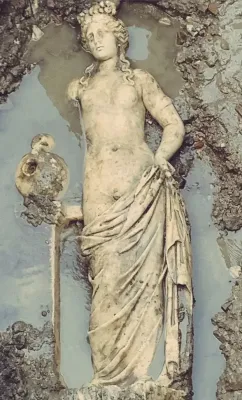 Amastris - Excavations in the ancient city of Amastris, located in the Black Sea province of Bartın’s Amasra district, have unearthed a statue of a nymph thought to be 1800 years old. In the statement made on the social media account of the Excavations and Research Department of the General Directorate of Cultural Heritage and Museums of the Ministry of Culture and Tourism, the following statements were made: “In our excavations in Bartın, Amasra, Gymnasium, a 1.53-centimeter-high statue belonging to the 2nd century AD and considered to be a Nymphe (water nymph) was unearthed.” Situated in the ancient region of Paphlagonia, the original city seems to have been called Sesamus and it was mentioned by Homer.
Amastris - Excavations in the ancient city of Amastris, located in the Black Sea province of Bartın’s Amasra district, have unearthed a statue of a nymph thought to be 1800 years old. In the statement made on the social media account of the Excavations and Research Department of the General Directorate of Cultural Heritage and Museums of the Ministry of Culture and Tourism, the following statements were made: “In our excavations in Bartın, Amasra, Gymnasium, a 1.53-centimeter-high statue belonging to the 2nd century AD and considered to be a Nymphe (water nymph) was unearthed.” Situated in the ancient region of Paphlagonia, the original city seems to have been called Sesamus and it was mentioned by Homer.
https://arkeonews.net/beautiful-water-nymph-marble-statue-found-in-amastris-ancient-city/
PEROU – 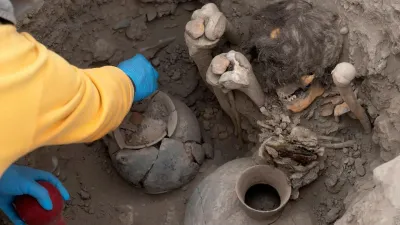 Huaca Pucllana - A team of archaeologists have unearthed a roughly 1,000 year-old mummy with well-preserved brown hair in Peru’s capital city of Lima. The mummified remains were found alongside preserved textiles, ceramic vessels, and other objects at the Huaca Pucllana monument, a 82-foot tall clay pyramid with an archaeological site hidden inside of a ceremonial grave. “This is an adult individual in a sitting position with bent legs,” head archaeologist Mirella Ganoza told Reuters. Ganoza noted that the mummy’s long hair and jaw were both nearly completely intact, but the sex of the individual is still unknown. Archaeologists have found other mummies and ancient offerings at the Huaca Pucllana site before. But there is still more to be uncovered, according to the team. Lima itself is home to about 400 sacred sites, with numerous archaeological ruins and mummies. Years of finds have been used to analyze the cultural, health, and social conditions of Indigenous Peruvians. In April, another 1,000 year old mummy was found about 15 miles from Lima at the Cajamarquilla archaeological site. Those remains were believed to be from an adolescent and some of the corpse’s skin was still distinguishable. It was found burning with at least 20 other individuals who are thought to be victims of human sacrifice.
Huaca Pucllana - A team of archaeologists have unearthed a roughly 1,000 year-old mummy with well-preserved brown hair in Peru’s capital city of Lima. The mummified remains were found alongside preserved textiles, ceramic vessels, and other objects at the Huaca Pucllana monument, a 82-foot tall clay pyramid with an archaeological site hidden inside of a ceremonial grave. “This is an adult individual in a sitting position with bent legs,” head archaeologist Mirella Ganoza told Reuters. Ganoza noted that the mummy’s long hair and jaw were both nearly completely intact, but the sex of the individual is still unknown. Archaeologists have found other mummies and ancient offerings at the Huaca Pucllana site before. But there is still more to be uncovered, according to the team. Lima itself is home to about 400 sacred sites, with numerous archaeological ruins and mummies. Years of finds have been used to analyze the cultural, health, and social conditions of Indigenous Peruvians. In April, another 1,000 year old mummy was found about 15 miles from Lima at the Cajamarquilla archaeological site. Those remains were believed to be from an adolescent and some of the corpse’s skin was still distinguishable. It was found burning with at least 20 other individuals who are thought to be victims of human sacrifice.
https://www.popsci.com/science/peru-mummy-hair/
ISRAEL - Pool of Siloam - A biblical site where Jesus is said to have ‘healed a blind man’ has been unearthed for the first time in 2,000 years. The Pool of Siloam is a historical site in Wadi Hilweh - a neighborhood archaeologists believe is the original site of Jerusalem - south of the walls of Jerusalem's Old City. The Pool of Siloam was built as part of Jerusalem’s water system about 2,700 years ago in the 8th Century BC, during the reign of King Hezekia. It is famous for being the spot where Jesus restored the sight of a blind man, as cited in a passage in the Gospel of John.
Pool of Siloam - A biblical site where Jesus is said to have ‘healed a blind man’ has been unearthed for the first time in 2,000 years. The Pool of Siloam is a historical site in Wadi Hilweh - a neighborhood archaeologists believe is the original site of Jerusalem - south of the walls of Jerusalem's Old City. The Pool of Siloam was built as part of Jerusalem’s water system about 2,700 years ago in the 8th Century BC, during the reign of King Hezekia. It is famous for being the spot where Jesus restored the sight of a blind man, as cited in a passage in the Gospel of John.
https://www.unilad.com/news/travel/missing-continent-found-scientists-zealandia-962831-20230903
ETHIOPIE –  Porc-Epic cave - A huge stash of reddish minerals from a cave in Ethiopia shows how Stone Age people gradually adapted their technologies and practices over a 4500-year period. “It’s one of the rare sites where we can see a very precise evolution of this cultural feature through thousands of years,” says Daniela Rosso at the University of Valencia in Spain. Rosso and her colleagues studied materials from Porc-Epic cave in Ethiopia. The cave first became known to scientists in the 1930s, and was thoroughly excavated in the 1970s. It was used by people throughout the Stone Age, but the bulk of archaeological material dates from a 4500-year-long period about 40,000 years ago. This material included 4213 pieces of “ochre” – an umbrella term for minerals that are rich in iron and consequently have vivid colours: typically red. Prehistoric people often collected these minerals, but the original excavators of Porc-Epic did not study them. “This is the first time there is a systematic study of ochre use at this site,” says Rosso.
Porc-Epic cave - A huge stash of reddish minerals from a cave in Ethiopia shows how Stone Age people gradually adapted their technologies and practices over a 4500-year period. “It’s one of the rare sites where we can see a very precise evolution of this cultural feature through thousands of years,” says Daniela Rosso at the University of Valencia in Spain. Rosso and her colleagues studied materials from Porc-Epic cave in Ethiopia. The cave first became known to scientists in the 1930s, and was thoroughly excavated in the 1970s. It was used by people throughout the Stone Age, but the bulk of archaeological material dates from a 4500-year-long period about 40,000 years ago. This material included 4213 pieces of “ochre” – an umbrella term for minerals that are rich in iron and consequently have vivid colours: typically red. Prehistoric people often collected these minerals, but the original excavators of Porc-Epic did not study them. “This is the first time there is a systematic study of ochre use at this site,” says Rosso.
https://www.newscientist.com/article/2391272-cave-art-pigments-show-how-ancient-technology-changed-over-4500-years/
NORVEGE –  Lauvhøe - Previously, archaeologists from Secrets of the Ice, a glacial archaeology organization affiliated with Norway's Department of Cultural Heritage, had found quite a few arrow shafts dating from the Iron and Middle Ages. During one expedition, the Norwegian archaeologists even found a 4th-century AD Roman sandal. Now, in the same vicinity, they found something much older after the ice at the site melted. The recent find predates other artifacts found at Lauvhøe by at least 2,000 years, judging from the arrow’s shape and craftsmanship. The pressure-flaked stone projectile is typical of Stone Age technology. The scientists will know for sure when they submit a wood sample for radiocarbon dating once the field season (period for archeological work in the area) concludes. This arrow shaft was likely employed by ancient hunters pursuing reindeer. These creatures would ascend to the icy heights during summer, seeking refuge from pesky flies. Stone Age hunters likely stalked this prey, waiting for the right moment to shoot their arrows — but this one must have missed, plunging into the snow.
Lauvhøe - Previously, archaeologists from Secrets of the Ice, a glacial archaeology organization affiliated with Norway's Department of Cultural Heritage, had found quite a few arrow shafts dating from the Iron and Middle Ages. During one expedition, the Norwegian archaeologists even found a 4th-century AD Roman sandal. Now, in the same vicinity, they found something much older after the ice at the site melted. The recent find predates other artifacts found at Lauvhøe by at least 2,000 years, judging from the arrow’s shape and craftsmanship. The pressure-flaked stone projectile is typical of Stone Age technology. The scientists will know for sure when they submit a wood sample for radiocarbon dating once the field season (period for archeological work in the area) concludes. This arrow shaft was likely employed by ancient hunters pursuing reindeer. These creatures would ascend to the icy heights during summer, seeking refuge from pesky flies. Stone Age hunters likely stalked this prey, waiting for the right moment to shoot their arrows — but this one must have missed, plunging into the snow.
https://www.zmescience.com/science/archaeology/archaeologists-find-stone-age-arrow-trapped-in-ice-in-norway/
GRECE – 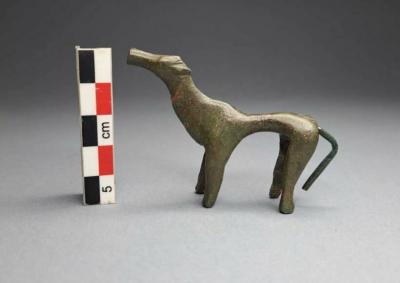
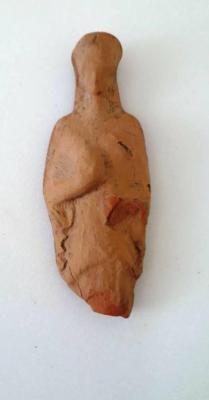
 Elikis - En Grèce, des fouilles archéologiques organisées dans un ancien temple datant de 2 800 ans ont permis de mettre au jour plusieurs artefacts. Parmi les objets : des figurines représentant une femme, un chien ou encore un serpent, relate Live Science. Le ministère grec de la Culture a indiqué que certaines des figurines identifiées dans ce sanctuaire pourraient avoir été utilisées comme des ex-voto, des objets que l’on dépose dans une chapelle ou dans une église, en accomplissement d’un vœu ou en guise de remerciement. Une autre hypothèse a été émise par le ministère : certaines figurines auraient pu être des cadeaux destinés à des dieux grecs, notamment Poséidon. Et pour cause, le sanctuaire où elles ont été découvertes – situé dans l’ancienne ville d’Elikis (aussi appelée Hélice), qui se trouve sur la côte nord du Péloponnèse – aurait été édifié pour vénérer les dieux grecs, en particulier celui de la mer. Dans un communiqué de presse du ministère de la Culture, on apprend que les archéologues ont également analysé les sédiments du site où les différents artefacts se trouvaient. Leurs travaux leur ont permis de comprendre que le sanctuaire avait été inondé à diverses reprises. Des événements qui se seraient déroulés il y a près de 2 800 ans. Plus récemment, il y a environ 2 300 ans, le temple était tombé en ruine au moment où un tremblement de terre – associé à un tsunami – avait détruit la ville. D’après ScienceAlert, la figurine à l’effigie d’un chien serait constituée de bronze, tandis que celle qui représente une femme aurait été faite à partir d’argile. Par ailleurs, les chercheurs ont découvert une tête de serpent (également en bronze), une partie d’un collier en or et une aile (faite d’argile) qui aurait pu faire partie d’une sirène ou d’un sphinx.
Elikis - En Grèce, des fouilles archéologiques organisées dans un ancien temple datant de 2 800 ans ont permis de mettre au jour plusieurs artefacts. Parmi les objets : des figurines représentant une femme, un chien ou encore un serpent, relate Live Science. Le ministère grec de la Culture a indiqué que certaines des figurines identifiées dans ce sanctuaire pourraient avoir été utilisées comme des ex-voto, des objets que l’on dépose dans une chapelle ou dans une église, en accomplissement d’un vœu ou en guise de remerciement. Une autre hypothèse a été émise par le ministère : certaines figurines auraient pu être des cadeaux destinés à des dieux grecs, notamment Poséidon. Et pour cause, le sanctuaire où elles ont été découvertes – situé dans l’ancienne ville d’Elikis (aussi appelée Hélice), qui se trouve sur la côte nord du Péloponnèse – aurait été édifié pour vénérer les dieux grecs, en particulier celui de la mer. Dans un communiqué de presse du ministère de la Culture, on apprend que les archéologues ont également analysé les sédiments du site où les différents artefacts se trouvaient. Leurs travaux leur ont permis de comprendre que le sanctuaire avait été inondé à diverses reprises. Des événements qui se seraient déroulés il y a près de 2 800 ans. Plus récemment, il y a environ 2 300 ans, le temple était tombé en ruine au moment où un tremblement de terre – associé à un tsunami – avait détruit la ville. D’après ScienceAlert, la figurine à l’effigie d’un chien serait constituée de bronze, tandis que celle qui représente une femme aurait été faite à partir d’argile. Par ailleurs, les chercheurs ont découvert une tête de serpent (également en bronze), une partie d’un collier en or et une aile (faite d’argile) qui aurait pu faire partie d’une sirène ou d’un sphinx.
https://www.geo.fr/histoire/ces-figurines-decouvertes-dans-un-temple-grec-etaient-elles-des-offrandes-a-poseidon-elikis-216496
MEXIQUE – 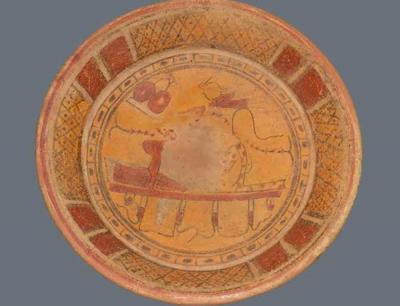 Cansacbé - Le site historique de Cansacbé au Mexique est réputé pour sa richesse archéologique. En effet, les chercheurs découvrent régulièrement de nouveaux artefacts liés à la civilisation maya. Une récente découverte a surpris les archéologues de par son état de conservation et sa nature. Les scientifiques du National Institute of Anthropology and History (INAH) ont effectivement exhumé un objet maya pas comme les autres dans une sépulture dédiée à un homme. Cet objet est un ancien plat maya en céramique qui représente une entité surnaturelle. Ce n’était pas un signe de malédiction à l’époque précolombienne, mais plutôt une offrande faite aux défunts. Les scientifiques ont déjà élaboré une théorie pour expliquer la signification de ce plat. Dans un communiqué officiel, l’INAH explique que ce plat en céramique date probablement de la période du classique ancien de la Mésoamérique. Il aurait donc été fabriqué entre 600 et 900 après J.-C. Le plus étonnant est surtout le motif qui a été peint par les Mayas sur la céramique. Il représente une entité mystique et plus spécifiquement un « wahyis ». Dans la mythologie maya, un wahyis est un esprit ou un être protecteur. Des objets le représentant étaient donnés en offrande funéraire aux défunts.. Nous ne connaissons pas l’identité de l’homme enterré à cet endroit, mais il s’agit probablement d’un membre de l’élite maya. Les offrandes funéraires et les wahyis n’étaient effectivement pas distribués à n’importe qui. La peinture du plat s’est estompée par endroits, mais certains éléments sont toujours bien visibles. Les chercheurs ont ainsi pu identifier la représentation d’un jaguar ou d’un homme vêtu d’une peau de jaguar qui se tient debout sur un banc. Il est difficile de savoir exactement de quoi il s’agit. De plus, les archéologues ont remarqué que de petites cases sont réparties autour de la scène du jaguar ou de l’homme-jaguar. Ces cases pourraient représenter des carapaces de tortues.
Cansacbé - Le site historique de Cansacbé au Mexique est réputé pour sa richesse archéologique. En effet, les chercheurs découvrent régulièrement de nouveaux artefacts liés à la civilisation maya. Une récente découverte a surpris les archéologues de par son état de conservation et sa nature. Les scientifiques du National Institute of Anthropology and History (INAH) ont effectivement exhumé un objet maya pas comme les autres dans une sépulture dédiée à un homme. Cet objet est un ancien plat maya en céramique qui représente une entité surnaturelle. Ce n’était pas un signe de malédiction à l’époque précolombienne, mais plutôt une offrande faite aux défunts. Les scientifiques ont déjà élaboré une théorie pour expliquer la signification de ce plat. Dans un communiqué officiel, l’INAH explique que ce plat en céramique date probablement de la période du classique ancien de la Mésoamérique. Il aurait donc été fabriqué entre 600 et 900 après J.-C. Le plus étonnant est surtout le motif qui a été peint par les Mayas sur la céramique. Il représente une entité mystique et plus spécifiquement un « wahyis ». Dans la mythologie maya, un wahyis est un esprit ou un être protecteur. Des objets le représentant étaient donnés en offrande funéraire aux défunts.. Nous ne connaissons pas l’identité de l’homme enterré à cet endroit, mais il s’agit probablement d’un membre de l’élite maya. Les offrandes funéraires et les wahyis n’étaient effectivement pas distribués à n’importe qui. La peinture du plat s’est estompée par endroits, mais certains éléments sont toujours bien visibles. Les chercheurs ont ainsi pu identifier la représentation d’un jaguar ou d’un homme vêtu d’une peau de jaguar qui se tient debout sur un banc. Il est difficile de savoir exactement de quoi il s’agit. De plus, les archéologues ont remarqué que de petites cases sont réparties autour de la scène du jaguar ou de l’homme-jaguar. Ces cases pourraient représenter des carapaces de tortues.
https://www.science-et-vie.com/science-et-culture/un-plat-maya-representant-une-entite-surnaturelle-decouvert-au-mexique-112431.html
TURQUIE – 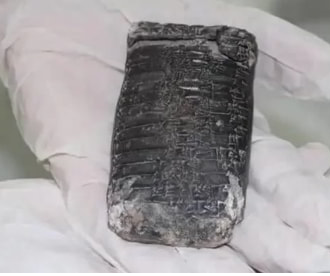 Aççana - Une tablette cunéiforme akkadienne vieille de 3 800 ans a été découverte lors des fouilles archéologiques menées dans le tumulus d’Aççana, la vieille ville d’Alalakh, dans le district de Reyhanlı de la ville de Hatay, dans le sud de la Turquie. Alalakh était l’une des villes les plus célèbres du monde antique ; elle faisait partie du grand royaume de Yamhad à l’âge du bronze moyen, était vassale du royaume mitannien à la fin de l’âge du bronze et a été incorporée à l’empire hittite à la fin du quatorzième siècle avant Jésus-Christ. Le tremblement de terre du 6 février, centré sur Kahramanmaraş, qui a causé d’importantes destructions dans la ville, a également affecté le tumulus du district de Reyhanlı, où se trouvait Alalah, la capitale du royaume de Muşki, pendant les périodes de l’âge du bronze moyen et de l’âge du bronze tardif. Sous la direction du ministère de la Culture et du Tourisme, des travaux de restauration et de conservation ont été entrepris dans le tumulus, où certaines parties des murs du palais ont été endommagées après le tremblement de terre. En enlevant les décombres du mur dans le cadre de l’étude, l’équipe a trouvé une tablette cunéiforme en argile parmi les vestiges. Le premier examen de la tablette akkadienne a permis de découvrir des informations concernant l’accord conclu par Yarim-Lim, le premier roi connu d’Alalakh, pour l’achat d’une autre ville. Akar a souligné que la tablette trouvée parmi les vestiges, datant de 3 800 ans, est bien conservée. « En enlevant les débris de quelques murs effondrés sur le monticule, il était très excitant de tomber sur une tablette qui n’avait jamais été touchée ou endommagée », a-t-il déclaré. Akar poursuit en indiquant que la période historique de l’artefact s’étend jusqu’à l’âge du bronze moyen. « Au cours de l’âge du bronze moyen, une période que nous définissons comme telle, nous observons que les rois de cette région possédaient un pouvoir économique. Cela est attesté par des exemples étonnants documentés dans les archives écrites. Dans cette tablette, nous voyons que Yarim-Lim, le premier roi connu d’Alalakh, avait l’intention d’acheter une autre ville et, à cet effet, a conclu un accord. Cela prouve que les rois de cette région avaient la capacité économique et le potentiel nécessaires pour acquérir une autre ville », a-t-il déclaré. Akar, qui a souligné que la tablette contribuerait également à la compréhension de la structure économique de l’époque, a déclaré : « La tablette contient probablement les noms de personnes importantes de la ville qui ont été témoins de cette vente. D’une certaine manière, il s’agit d’une liste de témoins de l’époque. L’artefact s’est révélé être un exemple exceptionnellement unique, en particulier pour comprendre la structure économique de l’époque, les relations entre les villes et le modèle économique et politique. »
Aççana - Une tablette cunéiforme akkadienne vieille de 3 800 ans a été découverte lors des fouilles archéologiques menées dans le tumulus d’Aççana, la vieille ville d’Alalakh, dans le district de Reyhanlı de la ville de Hatay, dans le sud de la Turquie. Alalakh était l’une des villes les plus célèbres du monde antique ; elle faisait partie du grand royaume de Yamhad à l’âge du bronze moyen, était vassale du royaume mitannien à la fin de l’âge du bronze et a été incorporée à l’empire hittite à la fin du quatorzième siècle avant Jésus-Christ. Le tremblement de terre du 6 février, centré sur Kahramanmaraş, qui a causé d’importantes destructions dans la ville, a également affecté le tumulus du district de Reyhanlı, où se trouvait Alalah, la capitale du royaume de Muşki, pendant les périodes de l’âge du bronze moyen et de l’âge du bronze tardif. Sous la direction du ministère de la Culture et du Tourisme, des travaux de restauration et de conservation ont été entrepris dans le tumulus, où certaines parties des murs du palais ont été endommagées après le tremblement de terre. En enlevant les décombres du mur dans le cadre de l’étude, l’équipe a trouvé une tablette cunéiforme en argile parmi les vestiges. Le premier examen de la tablette akkadienne a permis de découvrir des informations concernant l’accord conclu par Yarim-Lim, le premier roi connu d’Alalakh, pour l’achat d’une autre ville. Akar a souligné que la tablette trouvée parmi les vestiges, datant de 3 800 ans, est bien conservée. « En enlevant les débris de quelques murs effondrés sur le monticule, il était très excitant de tomber sur une tablette qui n’avait jamais été touchée ou endommagée », a-t-il déclaré. Akar poursuit en indiquant que la période historique de l’artefact s’étend jusqu’à l’âge du bronze moyen. « Au cours de l’âge du bronze moyen, une période que nous définissons comme telle, nous observons que les rois de cette région possédaient un pouvoir économique. Cela est attesté par des exemples étonnants documentés dans les archives écrites. Dans cette tablette, nous voyons que Yarim-Lim, le premier roi connu d’Alalakh, avait l’intention d’acheter une autre ville et, à cet effet, a conclu un accord. Cela prouve que les rois de cette région avaient la capacité économique et le potentiel nécessaires pour acquérir une autre ville », a-t-il déclaré. Akar, qui a souligné que la tablette contribuerait également à la compréhension de la structure économique de l’époque, a déclaré : « La tablette contient probablement les noms de personnes importantes de la ville qui ont été témoins de cette vente. D’une certaine manière, il s’agit d’une liste de témoins de l’époque. L’artefact s’est révélé être un exemple exceptionnellement unique, en particulier pour comprendre la structure économique de l’époque, les relations entre les villes et le modèle économique et politique. »
https://www.anguillesousroche.com/decouverte/decouverte-dune-tablette-cuneiforme-akkadienne-vieille-de-3800-ans-a-hatay-en-turquie/